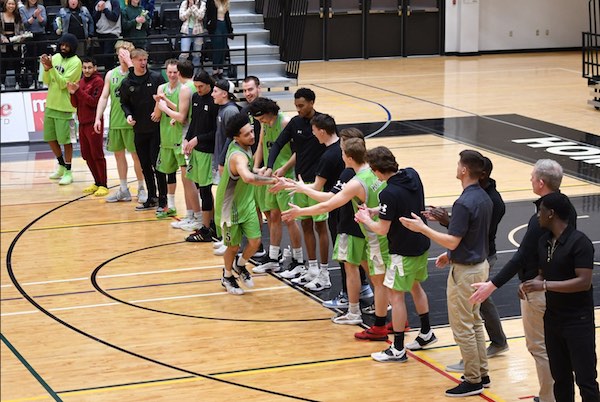Also Interesting
A Look at Red Deer’s Queens and Kings Basketball

Article submitted by Muhammad Nouman, photos from RDP Athletics
US college basketball often gets all the limelight, but Canadian basketball is seriously pulling off amazing feats in the sport. Situated in Red Deer, Alberta is Red Deer Polytechnic, a university that takes its sports and athletics seriously.
The school was founded in 1964 as Red Deer College but changed its name in 2021 to Red Deer Polytechnic. On the academic side, they offer apprenticeships, certificates, degrees, and micro-credentials. All this is impressive, but we are more interested in their sport.
Let’s take a look at what’s happening in Red Deer basketball at the moment.
A closer look at the Red Deer Polytechnic Kings
The Red Deer Kings and Queens just recently finished their season. It’s been a rollercoaster ride for the Kings after losing 87-81 to the Ambrose Lions and then beating them 95-78 the following day. Talk about nail-biting. During the first game, the Kings were looking good in the first half, but the Ambrose University Lions showed amazing offensive skill in the second half.
Coming out on top is Tyronn King with 23 points in the first Red Deer-Lions game and 13 points in the following game. On top of this, Tyronn King added eight of his team’s 43 rebounds, four assists, and one steal. Other players to notice are Kevin Szymanek, who recorded a double-double – 10 points and 12 boards, and Eduardo Crespo who totaled 19 points, eight assists, five rebounds, three steals, and a block.

Big changes for the Red Deer Polytechnic Kings
Speaking of Kings player’s rosters and who to look out for, Eduardo Crespo deserves some extra attention. Tyronn King, the Red Deer’s favorite is playing out his final season at the moment and the King’s head coach, Darren Graham has been scoping out a potential new leader for the team. At this point, Eduardo Crespo seems to be the most obvious choice. Eduardo Crespo is a 6 foot 4 international player who feels most comfortable playing in the “point guard” position. He recently moved over to Red Deer Polytechnic with high hopes of completing his degree as well as pouring energy into the King’s team, this means that he will be an asset to the team for another 4 to 5 seasons.
Crespo’s arrival at Red Deer has been a huge win for the Kings. He has international playing experience from his time in Spain and Italy and although he prefers “point guard”, is an incredibly talented well-rounded player. If you look at his stats, he is 2nd to Tyronn King with an average of 13.6 points, 6.1 rebounds, and 27.6 minutes per game. On top of that, Crespo has doubled his figures in the last 5 games.
A closer look at the Red Deer Polytechnic Queens
It’s been a celebration as this is the first season that the Red Deer Polytechnic Queens Basketball team has returned to the playoffs since the 2009/2010 season. Scoring well in their final, regular-season home game against the Lions, the Queen team locked in the fifth spot in the Alberta Colleges Athletic Conference (ACAC) South Division standings.

Current Interim Head Coach, Ed Major, has high hopes for the game to follow the Queens-Lions match when they go up against Medicine Hat. The previous game against Medicine Hat was held in November and Amy Szymanek was a player that stood out with a double-double, 26 points, and 11 rebounds. Another player who deserves a hat tip is Sophie Melin who scored an additional 15 points.
The Queens had a similar fate to the Kings with the Ambrose Lions, losing in the first game against the Lions (69-62) and coming out on top in the second game, scoring 83 points while the Lions only scored 74. Lauren France stood out in the second game, scoring a total of 25 points and going seven-for-17 from the three-point range.

Big changes for the Red Deer Polytechnic Queens
Much like the Kings, the Queens have been experiencing some major shifts and changes of their own. The most notable of these changes is the first mid-season coaching change in over 50 years. Mandy Botham, the team’s previous coach, resigned unexpectedly during the Christmas break and those in command had to scramble to find a replacement.
Luckily, Ed Major was up to the challenge and jumped at the opportunity. Major has ample experience with Alberta college basketball and had been keeping an eye on the Queens for some time. Prior to 2022, Major had been coaching for Notre Dame. He is confident that he can lead the Queens from their current 3-3 to a potential 5-1.
The Red Deer Polytechnic Queens have proven to be much more efficient from the free-throw line (65.6 to 58.9%) and in the three-point range (31.2 to 27%). The team plans to tackle their opponents “guns a blazing,” says Ed Major, they intend to give it their all.
Also Interesting
How to Deposit and Withdraw in CAD at Sol Casino: A Guide for Canadian Players

When choosing an online casino, Canadian players not only look for exciting games and bonuses but also for easy and secure payment methods in Canadian dollars (CAD). Sol Casino understands this need and has created a streamlined system for deposits and withdrawals that suits players across Canada.
This guide walks you through how to fund your account, cash out your winnings, and which methods are most efficient and convenient.
Why Use CAD at Sol Casino?
Sol Casino supports transactions directly in Canadian dollars, which is a huge advantage. This means:
No currency conversion fees
Simplified banking
Faster transactions
Better tracking of your gambling budget
For Canadian players, avoiding unnecessary fees and delays is crucial. Sol Casino ensures you can deposit and withdraw in your local currency without any added complications.
How to Deposit Funds at Sol Casino (Step by Step)
Funding your Sol Casino account is simple. Follow these steps to make a deposit:
1. Log in to your Sol Casino account.
2. Go to the Cashier/Deposit section.
3. Choose your preferred payment method.
4. Enter the amount you wish to deposit (minimum deposit usually starts at $20 CAD).
5. Follow the prompts to complete the transaction.
Most deposits are instant, meaning you can start playing right away.
Popular Deposit Methods for Canadians
Sol Casino offers a variety of trusted options tailored for Canadian players:
Interac e-Transfer: A go-to choice in Canada, easy to use and highly secure.
MuchBetter: A modern e-wallet app offering fast, private transfers.
ecoPayz: Another reliable e-wallet widely used in Canada.
Visa/Mastercard: Traditional and familiar for most users.
Cryptocurrencies: Includes Bitcoin, Ethereum, and more for added privacy.
Each method is secure and designed to fit your lifestyle and preferences.
How to Withdraw Winnings in CAD
Cashing out your winnings is just as easy. Here’s how to request a withdrawal:
1. Go to your account dashboard and select Withdraw.
2. Choose the same method used for depositing (if possible).
3. Enter the amount you want to withdraw.
4. Submit your request and wait for confirmation.
Before processing your first withdrawal, Sol Casino may ask for ID verification to comply with KYC (Know Your Customer) rules. This is standard for any legitimate casino and helps protect your account from fraud.
Withdrawal Processing Time
Sol Casino processes withdrawal requests quickly. Here’s a general idea of how long it may take:
E-wallets (MuchBetter, ecoPayz): 0–24 hours
Cryptocurrency: 1–12 hours (depending on network speed)
Interac: 1–2 business days
Cards (Visa/Mastercard): Up to 3–5 business days
Once your identity is verified, future withdrawals are often processed faster.
Tips for Smooth Transactions
Verify your account early to avoid delays during your first withdrawal.
Use the same method for deposit and withdrawal whenever possible.
Set responsible limits to manage your gambling activity.
Watch for promotions offering cashback or deposit bonuses for specific payment methods.
Sol Casino also sends notifications and email confirmations for each transaction, adding transparency to the process.
Customer Support for Payment Issues
If you run into any trouble while depositing or withdrawing, Sol Casino has a 24/7 support team ready to help. You can use:
Live chat for immediate assistance
Email support for more detailed inquiries
FAQ section with answers to common questions about payments
All services are available in English and French, making support accessible to all Canadian users.
Conclusion: Fast, Flexible, and Canadian-Friendly Banking
Sol Casino has built a payment system that respects Canadian needs. With support for CAD, a variety of local methods like Interac and MuchBetter, and fast withdrawals, it provides a hassle-free banking experience. Whether you’re playing for fun or aiming for big wins, Sol Casino ensures your money is handled safely, securely, and efficiently.
Also Interesting
Actuators in Industrial Automation: How They Improve Efficiency

In the quest for enhanced productivity and reduced operational costs, many industries face challenges in optimizing their automation systems. Integrating advanced technologies, such as actuators, alleviates these issues by automating processes and minimizing manual intervention. Leveraging the capabilities of an actuator allows businesses to streamline operations and achieve higher efficiency.
Industrial automation continues to evolve, with a focus on precision and reliability. As of 2025, advancements in automation technologies are projected to increase productivity by up to 30% in various sectors, according to the International Federation of Robotics report. This growth is attributed to the strategic use of components like the actuator, pivotal in enhancing operational efficiency.
Actuators: What are They?
Actuators are mechanical devices that convert energy into motion and enable precise control over various industrial processes. They are categorized into:
Electric
Hydraulic
Linear
Each type offers unique advantages (e.g., precision, force, speed) for different applications. Understanding what actuators are and how they work is crucial for application in industrial settings.
The question “What are actuators?” is often followed by “What is the work of an actuator?” These devices perform tasks that require movement or force (e.g., opening valves, moving parts in machinery, or adjusting positions in assembly lines). They are integral to systems requiring precise control, making them a cornerstone of modern automation.
The Role of Actuators in Industrial Automation
Actuators are the backbone of industrial automation, enabling precise control and integration across systems. Their ability to convert energy into motion makes them indispensable for optimizing processes, reducing costs, and improving productivity.
In control systems, they work with sensors to enable real-time adjustments. For example, in food processing plants, electric motors adjust conveyor speeds, ensuring consistent packaging and reducing waste. It minimizes downtime and saves businesses time and money.
In robotics, devices like the actuator arm deliver high precision. In automotive assembly lines, linear drives allow robotic arms to weld or paint with millimeter accuracy, reducing rework and enhancing product quality.
Beyond robotics, these motors streamline machinery operations. In the oil and gas industry, hydraulic motors control pipeline valves, eliminating manual intervention in hazardous environments and improving safety.
How Actuators Improve Operational Efficiency
Here is how actuators enhance industrial operation:
They offer precise control over movements, essential in applications requiring high accuracy (e.g., manufacturing, robotics). It reduces errors and improves product quality. For example, in CNC machining, linear actuators ensure cuts are made with exactness, resulting in parts that meet precise specifications.
They speed up production cycles, allowing for higher output in less time. It is beneficial in assembly lines where actuator assembly and actuator adapter components are used to streamline processes. In automotive manufacturing, they can quickly position and secure parts, reducing assembly time.
They minimize the need for human intervention, reducing the risk of errors and accidents. It improves safety and increases productivity by allowing workers to focus on more complex tasks.
In environments where repetitive tasks are common, motors automate these processes, freeing up personnel for strategic roles.
Applications of Actuators in Various Industries
Actuators are used across different industries to enhance efficiency and productivity.
Manufacturing. Linear drives are used in machinery to ensure precise movements and consistent product quality. They are integral in assembly lines, where they automate tasks such as positioning and lifting components. For instance, in electronics manufacturing, actuators precisely place components on circuit boards, ensuring each product meets quality standards.
Oil and gas. Here, hydraulic motors are used for valve control due to their high force capabilities, necessary for handling heavy loads.
Food processing. In this niche, electric motors are preferred for their cleanliness and low maintenance, ensuring production lines remain hygienic and efficient. They are used in machinery requiring precise control (e.g., filling and packaging systems).
How to Choose the Right Industrial Actuator
Evaluate several factors for optimal compatibility with your applications:
Determine whether your application demands linear, rotary, or oscillatory motion. For example, linear motors are ideal for tasks requiring straight-line movement, such as positioning components in manufacturing lines.
Assess the load capacity and force requirements of your application. Heavy-duty applications, like those in the oil and gas sector, often require hydraulic actuators due to their high force capabilities.
Evaluate the operating environment, considering factors such as temperature, humidity, dust, and corrosive conditions. Ensure the actuator’s materials and design are suitable for these conditions by checking IP ratings, temperature limits, and corrosion resistance.
Ensure the motor is compatible with existing control systems. It includes considering manual, mechanical, electrical, or computer-based control options to ensure integration.
Consider safety factors (e.g., emergency stop mechanisms and fail-safe designs), especially in critical applications like vehicle automation.
Actuators are essential in industrial automation, delivering precision, speed, and efficiency to optimize operations across sectors. Integrating the right motors will allow businesses to reduce costs, enhance productivity, and maintain a competitive edge in an automated landscape.
-

 2025 Federal Election2 days ago
2025 Federal Election2 days agoBREAKING: THE FEDERAL BRIEF THAT SHOULD SINK CARNEY
-

 John Stossel2 days ago
John Stossel2 days agoClimate Change Myths Part 2: Wildfires, Drought, Rising Sea Level, and Coral Reefs
-

 2025 Federal Election2 days ago
2025 Federal Election2 days agoCHINESE ELECTION THREAT WARNING: Conservative Candidate Joe Tay Paused Public Campaign
-

 Media2 days ago
Media2 days agoCBC retracts false claims about residential schools after accusing Rebel News of ‘misinformation’
-

 Business2 days ago
Business2 days ago‘Great Reset’ champion Klaus Schwab resigns from WEF
-

 Bjorn Lomborg2 days ago
Bjorn Lomborg2 days agoNet zero’s cost-benefit ratio is CRAZY high
-

 International2 days ago
International2 days agoPope Francis’ funeral to take place Saturday
-

 Business20 hours ago
Business20 hours agoTrump: China’s tariffs to “come down substantially” after negotiations with Xi





